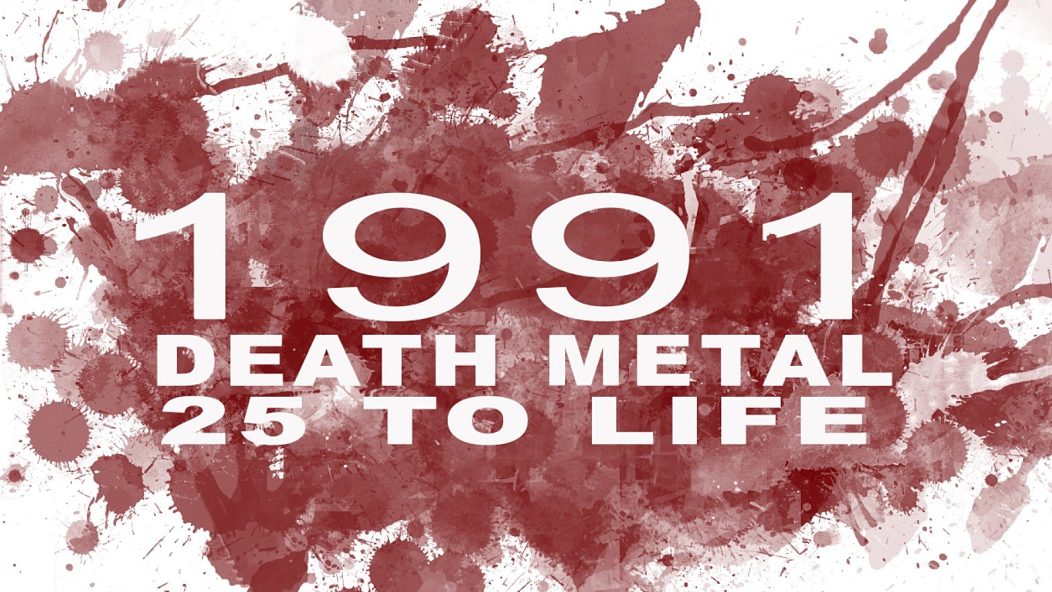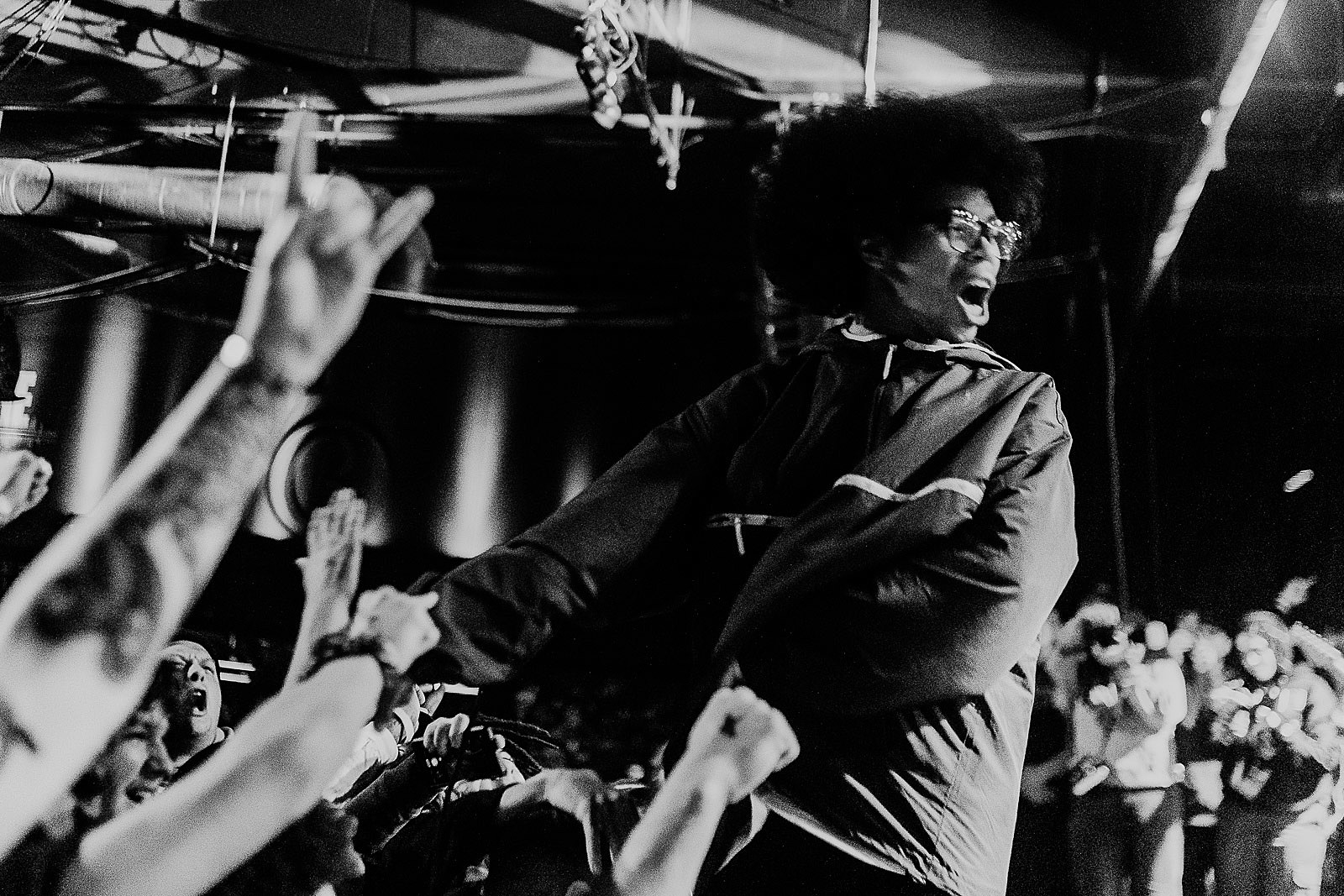
Death Metal 25 to Life: October - December 1991

…
This is it, the last day of our look back at the greatest year in death metal. In this bounty of brutality, New York continues to impress, death metal gets philosophic and we take a journey into the medical texts.
Before we leave you to it, let’s take a moment to peruse the cover art on display throughout this series. We’ve gone on at length about death metal’s rich musical versatility in this most important of years, but check the artwork. From the serene moonlit meadow of Unquestionable Presence, to the alluring symmetry of Like an Everflowing Stream and Clandestine to From Beyond’s bad trip psychedelia and the hellish landscapes depicted on Dawn of Possession, The Ten Commandments and Effigy of the Forgotten, death metal art is an entire medium unto itself. And of that medium, Dan Seagrave is undoubtedly its da Vinci. No two of his works are quite alike, but many feature running themes: bold color palettes, otherworldly machinery, humanoid features hidden in inanimate objects. A wickedly inventive mind still at work today, gracing modern death metal albums with his angular rock formations and black hole vortices, Seagrave also had his breakout year in ‘91. This series is as much a gallery for great death metal art as it is the punishing tunes within. So let’s get to the last entry.
…

…
Suffocation – Effigy of the Forgotten (October 8th)
Every lame suburban tech-death band owes its existence to Suffocation and Effigy of the Forgotten. Where your local opener for the upcoming Origin show always fails however, is in understanding what made Suffocation so lethal. It wasn’t Terrance Hobbs and Doug Cerrito’s digit-shredding solos or a bevy of tempo changes, it was their fucking riffs. When it comes to riffs, Effigy of the Forgotten is a loaded treasure chest–from the first seconds of “Liege of Inveracity,” the caffeine-addicted ear-worms bore in and refuse to leave. The only chords that are held for longer than a fraction of a second are heard on the intro to “Involuntary Slaughter,” and even those are quickly tossed aside for Mike Smith’s precision pounding.
Suffocation’s mastery of technical death metal was entirely apparent on Effigy of the Forgotten; the audacity with which Hobbs and Cerrito crammed every single buzzing, tangled riff into these songs reeked of cocky confidence. Vocalist Frank Mullen was the only element that needed catching up but even then, his distorted croaks served their purpose just fine here. Much like Helloween and the power metal genre, Suffocation refined their blazing, cranium-warping sound with such speed and effectiveness that their followers were destined to fail. They spent too much time on bedroom chops and compositional complexity, rather than the effortlessly magnetic stabs that Hobbs and Cerrito unsheathed. Their efforts are what make Effigy of the Forgotten the apex of the tech-death sound, an album whose virtuosity never steps on the toes of an endlessly catchy lick.
–Avinash Mittur
…
…

…
Benediction – The Grand Leveller (October 10th)
Depending on who you ask, Dave Ingram has the either the worst or best luck in his field. The highlights of career have been when he’s replaced a legendary death metal vocalist in an established band. While it means that he’s been given many chances to shine before a pre-allocated audience, it also means that he’s had to stand in the shadow of some rather talented singers. In 2016 he played a triumphant set with Hail of Bullets, replacing Martin Van Drunen, while in 1991 he introduced himself to the metal world as Mark “Barney” Greenway’s successor in Benediction on their second record, The Grand Leveller.
Unlike many of their peers in the late ‘80s Birmingham scene, Benediction played their death metal straight: no grind, no prog and no crust. If they had an analog in the death metal world in 1991, the closest act might have been Sweden’s Grave. Both bands played with a cold, factory-like precision. The swinging mosh-riffs in the title track and “Opulence of the Absolute” are among the few times that Benediction loosens up, but otherwise the name of the game is dead-eyed, no nonsense death metal. The militaristic beating that they offer throughout on The Grand Leveller that you can hear on “Born in a Fever” and the double-kick attack of “Senile Dementia” make for a formula that satisfies easily enough, though both Ingram and Benediction would reach much higher levels of performance and achievement on later outings.
–Avinash Mittur
…
…

…
Pungent Stench – Been Caught Buttering (October 10th)
Out of all the oddball albums in this week’s collection, none are nearly as weird as the second album by Pungent Stench. I don’t see a lot of writing in print or on the web about this Austrian outfit, and it’s easy to see why. Stylistically, they were all over the place. Bands like Atheist and Pestilence dabbled in progressive influences earlier in the year (arguably Death would master it two weeks later), but Pungent Stench skipped the music theory and went straight for the curious affectations, such as the Primus-ish slapping on “Sick Bizarre Refaced Creation”, or the Sabbath-ish interlude two minutes into “Happy Re-Birthday”. One gets the impression that, much like the lyrics and cover art, these little touches exist more for shock value and humorous edification than anything else, but like everything else Pungent Stench did, they went on to be emulated in brutal death metal and its various grinding, slamming subgenres ad nauseum. Emphasis on the nauseum. Even without all the experimentation, Pungent Stench would have made history with their gross-out lyrics. Cannibal Corpse retain the reputation of a sick sense of humor for their often-censored album covers but Pungent Stench really knew how to turn your stomach with a turn of phrase.
–Joseph Schafer
…
…

…
Death – Human (October 22nd)
Human often gets as much recognition for its lineup as it does for the actual music. That’s what happens when you draft a veritable Murderer’s Row of death metal musicians as your backing band. Chuck Schuldiner did just that by plucking guitarist Paul Masvidal and drummer Sean Reinert from nascent prog-death band Cynic, once again showing his eye for talent after hiring James Murphy to sling leads on Spiritual Healing a full three years before Obituary would nab him for the same role on Cause of Death. To round out the roster, Evil Chuck brought in fretless extraordinaire Steve DiGiorgio on bass. The result was the perfect marriage of Schuldiner’s ‘80s hard rock riffing sensibility and an increased focus on song structures and complex arrangements.
While the two had an infamous falling out after recording, Schuldiner and Masvidal sound like natural muses for one another on Human, the former imbuing songs like “Suicide Machine” with his trademark giant hooks while the latter’s leads explore the outer reaches of contemporary death metal. Continuing his social and philosophical musings from Spiritual Healing, Schuldiner dives further into his subconscious on “See Through Dreams,” crafting possibly the most self-reflective couplet in death metal: “Close your eyes and imagine to be without / What we take for granted every time we open our eyes.” While Death would go deeper still, Human sees Schuldiner’s project at the nexus of concise songwriting and tasteful experimentation.
–Greg Majewski
…
…

…
Carcass – Necroticism – Descanting the Insalubrious (October 30th)
In case you forgot, Phoebe from ‘Friends’ wanted Carcass to play her wedding. The writers behind the beloved sitcom believed in that gag so deeply that they made it twice in one episode. The joke works in part because it’s totally believable that someone who feels no need to make heavy metal a part of their personal aesthetic might like Carcass–at least I bet that’s what the writer was thinking. Carcass just has that kind of accessibility. Even in the late 80s when the band was laying the foundation for grindcore, Bill Steer, Ken Owen and Jeff Walker had a knack for hooks that their peers were still building up to, and neither the tropes of extreme metal nor the band’s propensity for hyper-exclusive medical lyrics could dull it. You can hear it in the intro to “Ruptured in Purulence”, you can hear it in “Genital Grinder” and you can hear it all over Necroticism.
Every Carcass album has it’s own genre identity. Reek of Putrefaction is the grind album, Heartwork is the melodic death metal album, and Necroticism is the technical album. Complex songs composed of multiple interlocking parts like “Incarnated Solvent Abuse” and “Corporal Jigsaw Quandary” boast longer runtimes overall than any other Carcass record and, more importantly, most other death metal songs from 1991. They sounded better too, more clear and precise than similarly difficult-to-play songs by Atheist and Pestilence earlier in 1991. Guitar leads from Michael Amott, now better known for his role in Arch Enemy, added melody and an aesthetic sheen to an album that Steer and Walker already mapped out as a conscious quantum leap forward from their past work. In 1991, Carcass played the game like they came down from a higher league. Hell, I’d ask them to play my wedding.
–Joseph Schafer
…
…

…
Entombed – Clandestine (November 12th)
Here it is, the end of the list; the last true death metal album in death metal’s greatest year. What began with a one-off foray into the realm of sweatpants and high-tops from a band who would go on to become a corpsepaint cornerstone now ends with the quintessential Swedish death metal band and the quintessential Swedish death metal album. Sporting a filthy Sunlight Studios production and perhaps the definitive album cover in Dan Seagrave’s portfolio, Clandestine rewrote the book on hooky-yet-brainy brutality and popularized many of the stylistic choices we take for granted in modern heavy music. HM-2 pedals pushed through overblown amps? D-beats ripped from British anarcho punk bands? Eerie film samples (not medical recordings. Thanks Carcass) strategically placed for maximum contextual impact? You can thank Entombed and their second LP for all of it.
But more than that, Clandestine just brings the riffs. “Sinners Bleed” alone is a treasure trove of start-stop crunch punctuated with horror-film violin stings leading into its cataclysmic breakdown-as-verse central theme. With sequencing and song structures that make it difficult to discern where one track ends and the next begins, Clandestine turns into a 43-minute pummeling, one chugging, buzzsaw riff after another. Which is to say, it rules. “Go ahead and look. I hope you like what you see!”
–Greg Majewski
…
…
Old School Death Metal Week continues: Part 1, Part 2, Part 3










